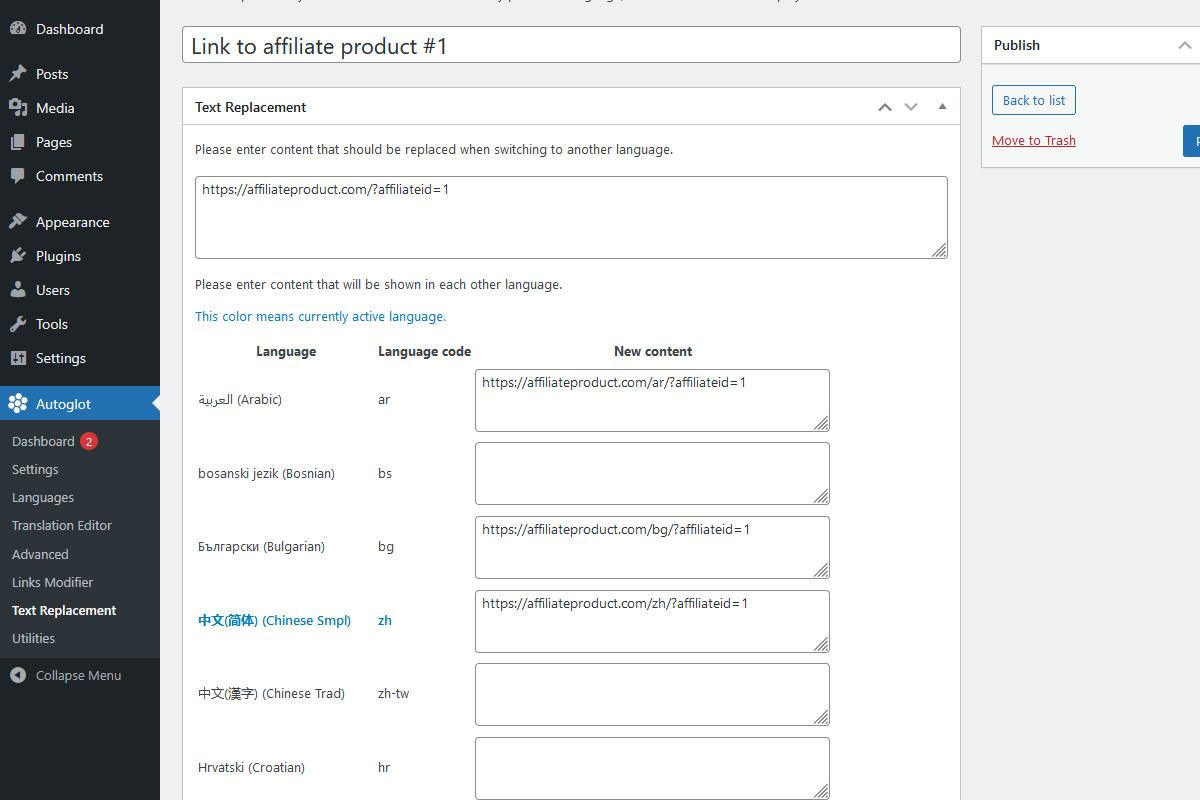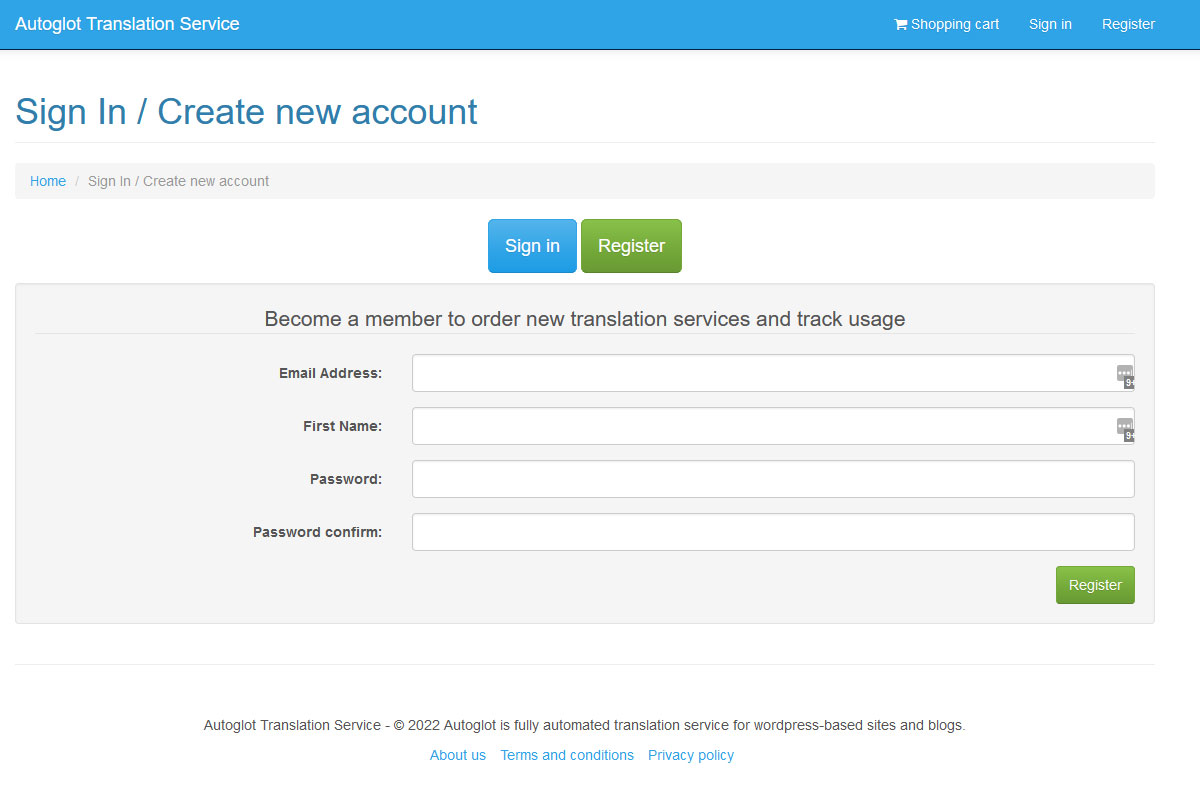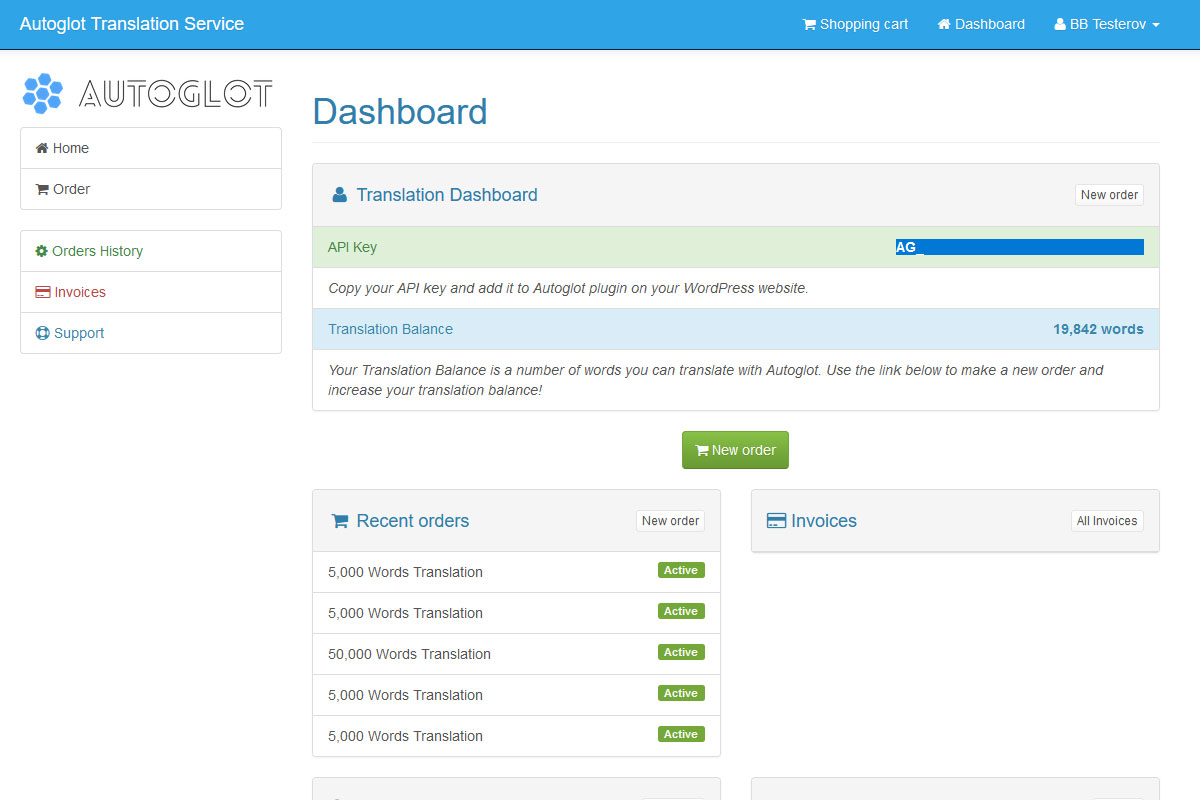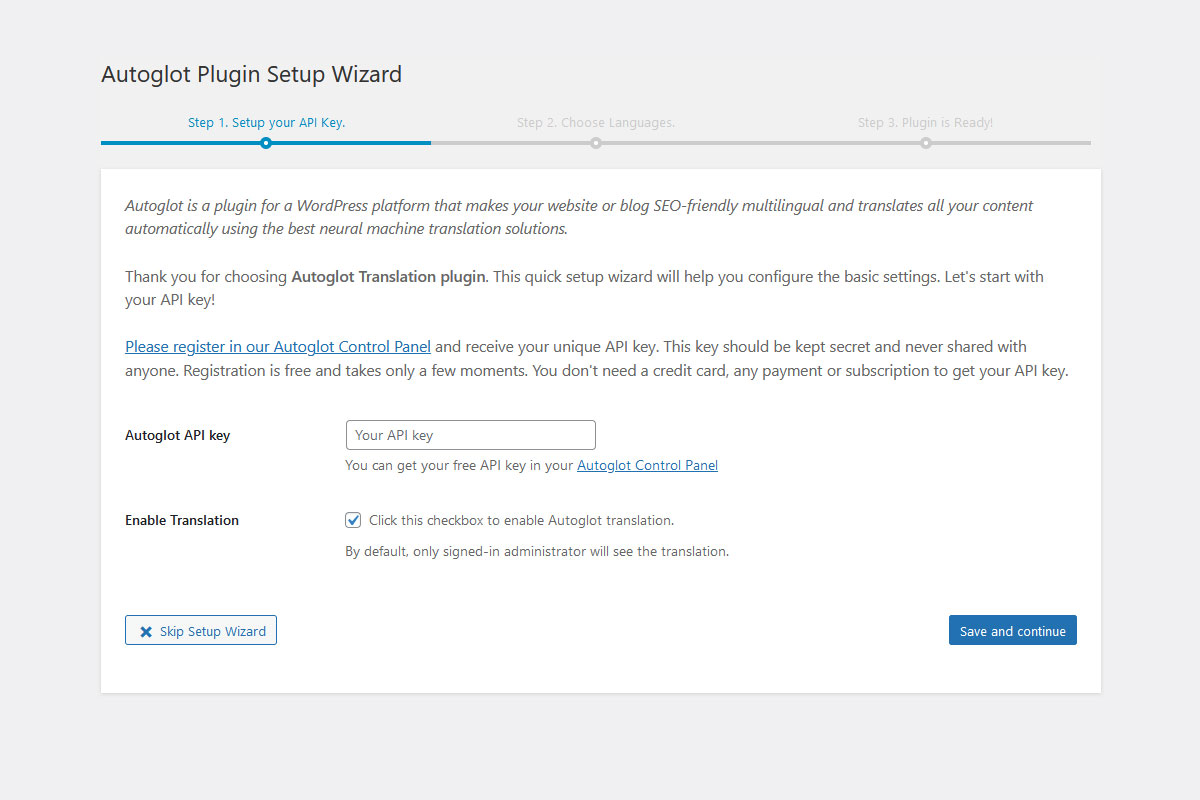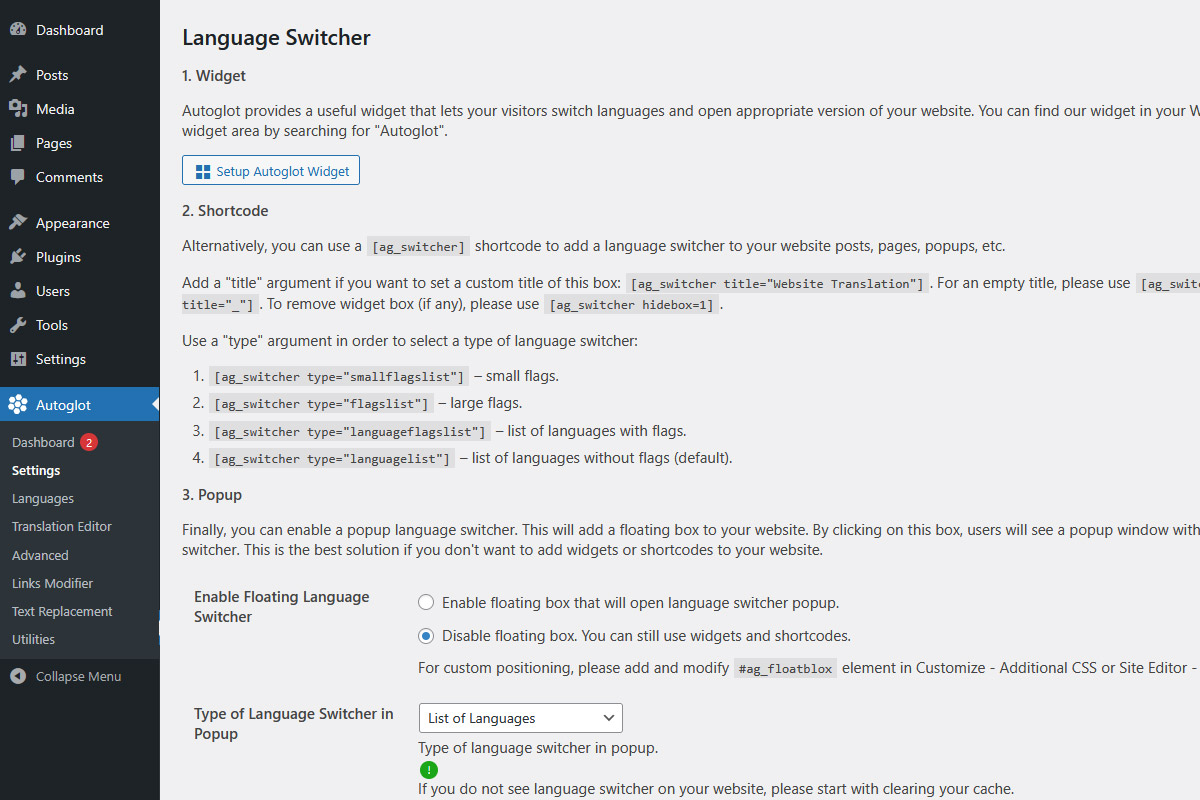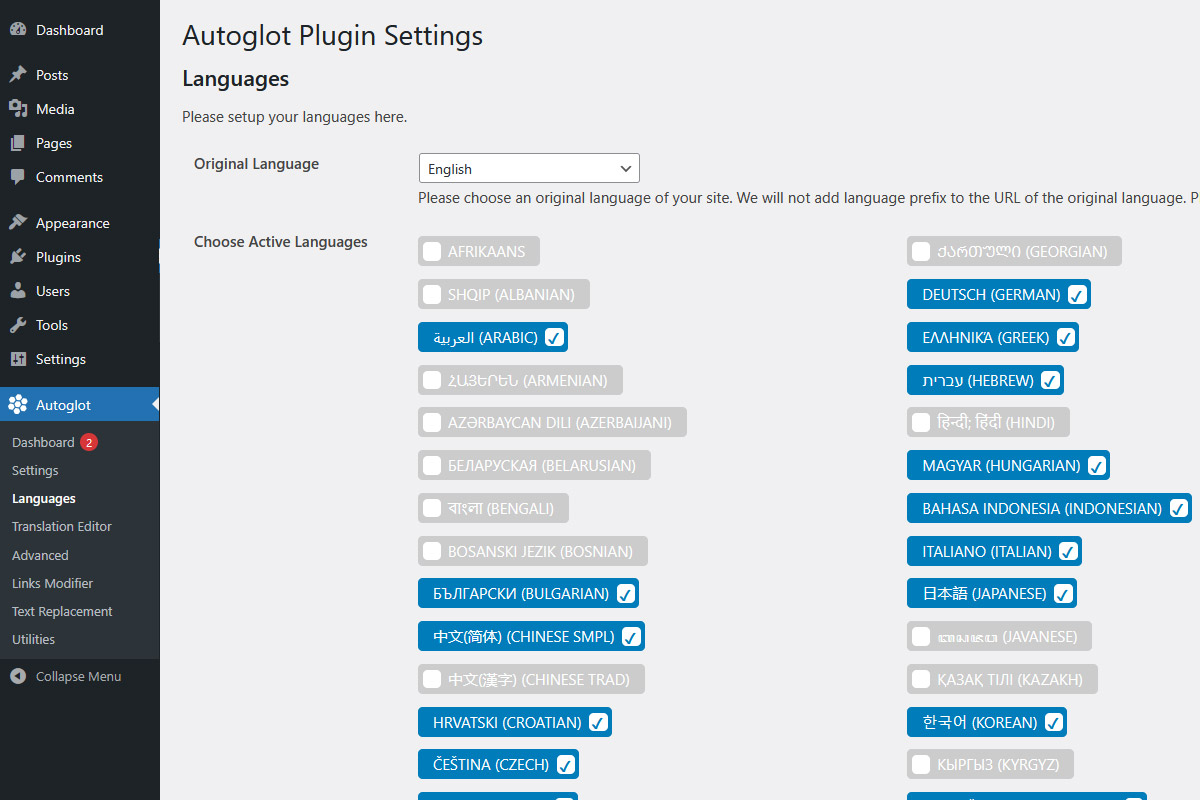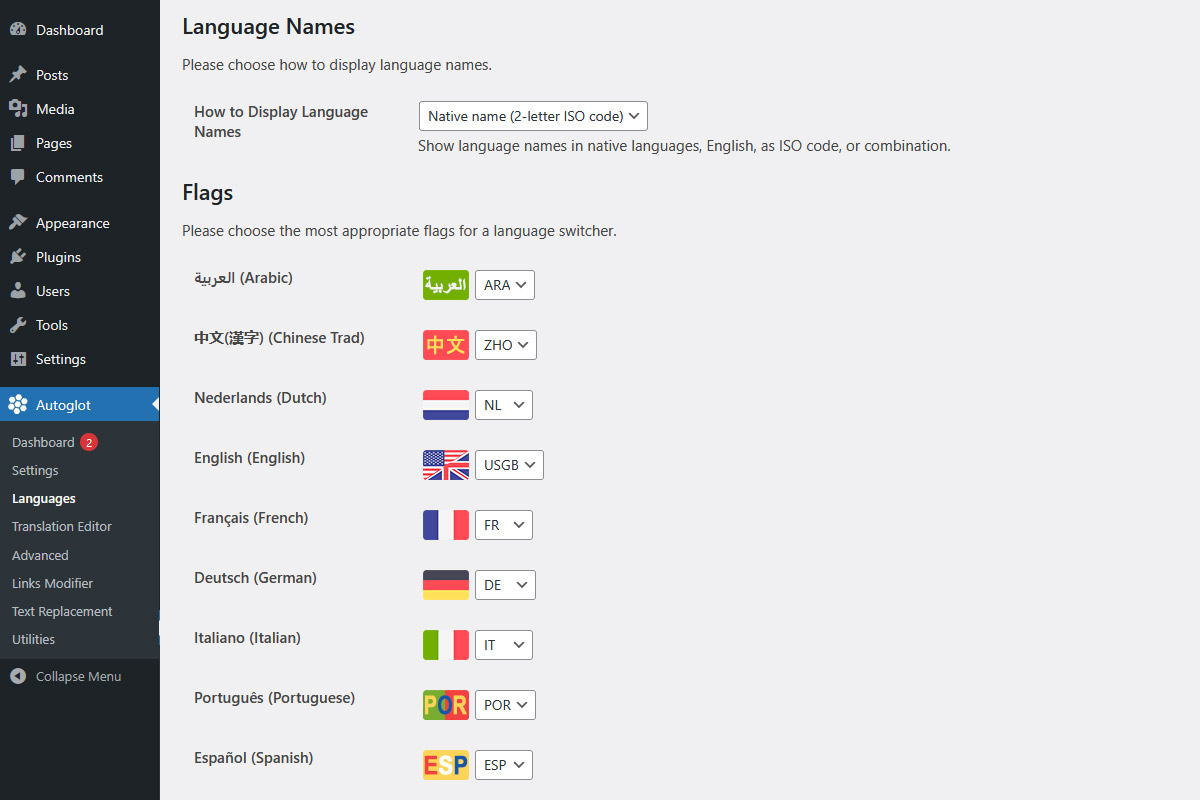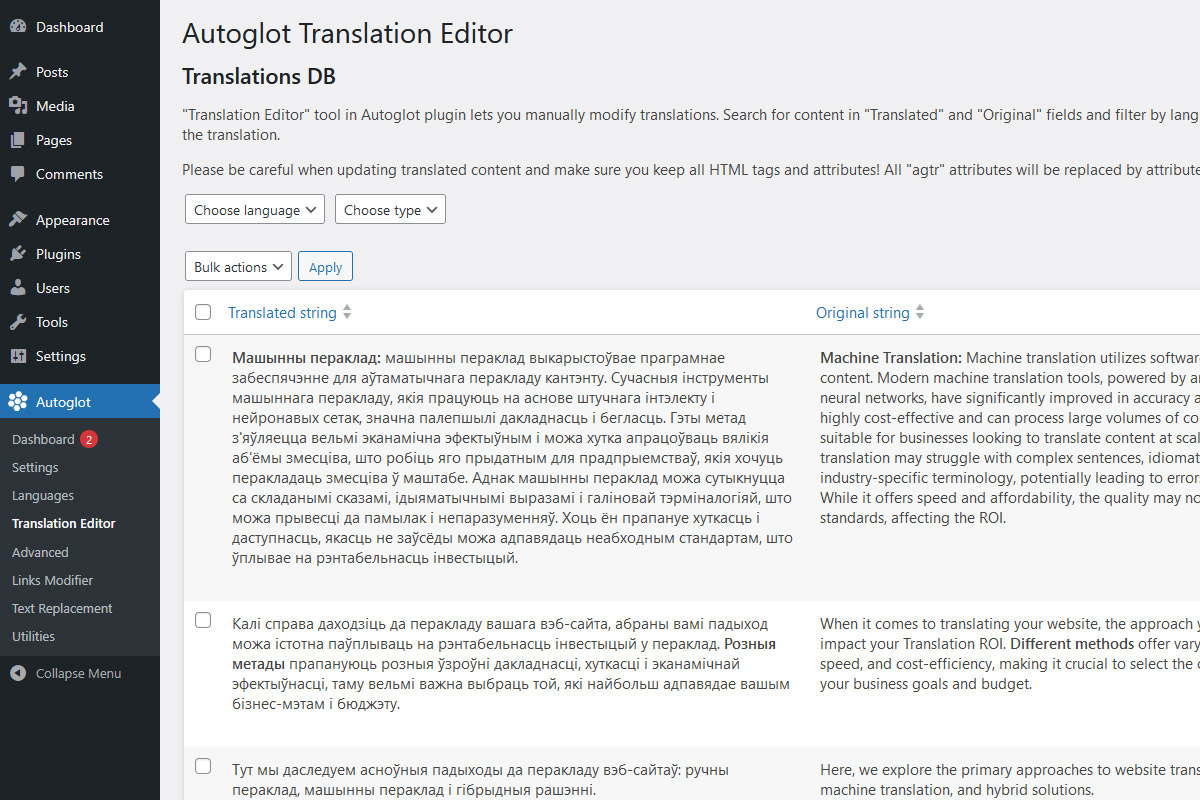
Automatic Multilingual Translation by Autoglot
| 开发者 | autoglot |
|---|---|
| 更新时间 | 2025年12月10日 22:58 |
| PHP版本: | 7.0 及以上 |
| WordPress版本: | 6.9 |
| 版权: | GPLv2 or later |
| 版权网址: | 版权信息 |
标签
下载
详情介绍:
- Each language gets its own fully crawlable version of your website. Autoglot adds a language prefix to your URLs (which can also be translated), ensuring search engines index your multilingual pages just like independent sites, bringing you more traffic and a wider audience.
- When a translated page is opened for the first time, Autoglot splits content into separate phrases or sections, and translates them with AI-powered machine translation into the current language, without modifying your original content. You can later fine-tune translations through a built-in editor.
- Your translations are stored locally and served instantly. Content is translated only once and saved in your database, with no hidden costs like pageview limits, bandwidth fees, or external subscriptions. It's like running several multilingual versions of your site, all managed from one place.
- Download our plugin from the official WordPress plugin storage and install it on your site.
- Register in our Autoglot Control Panel and receive your unique API key.
- Finally, add this API key to your Autoglot plugin and choose as many languages as you want for your new multilingual website!
- Autoglot widget. Simply search for "autoglot" in you widgets and add our widget to your sidebar or any other widgets area. You can choose a type of switcher: language names, flags, or both;
- Shortcode. Alternatively, you can use a [ag_switcher] shortcode to add a language switcher to your website posts, pages, popups, etc. See FAQ section for more information about shortcode options.
- Popup. Finally, you can enable a popup language switcher. This will add a floating box to your website. By clicking on this box, users will see a popup window with language switcher. This is the best solution if you don't want to add widgets or shortcodes to your website.
- Small to midsize businesses (SMB): Seeking a cost-effective way to expand internationally? Autoglot eliminates the complexities of manual translation, providing SMBs an effortless way to connect with a global audience. Manage your resources wisely and watch your business reach new heights without the hassle.
- Enterprise companies: Handling vast amounts of content? Autoglot offers a scalable solution to automatically translate large volumes of content. Automating translation reduces costs while maintaining a consistent, rapid workflow.
- Content creators and bloggers: Break language barriers and amplify your influence. Autoglot quickly translates your content, letting you focus on creating captivating material that resonates globally.
- Affiliate and internet marketers: Time is money. Autoglot streamlines multilingual versions of affiliate and marketing websites, removing the need for manual translation and constant updates. Promote offers effortlessly and maximize reach and revenue.
- E-commerce stores: Expand your sales globally by automatically translating product pages, descriptions, and the most of checkout processes. Deliver a seamless shopping experience for international customers, boost conversions, and grow revenue without manual translation.
- Please use classic cart and checkout pages. New block pages are JavaScript-based and therefore cannot be translated on the server.
- In addition to the words calculated in the Word Counter, please allocate up to 1,000 words per language for translation of cart and checkout pages.
- WooCommerce may show unique dynamic messages for different users. If they have not been shown before, Autoglot will translate them using the translation balance.
- Currently, Autoglot does not translate outgoing emails in order to prevent excess charges.
安装:
- WordPress 5.0 or greater
- PHP version 7.0 or greater
- PHP curl and libxml libraries
- Rewrite rules
- Permalinks enabled
- Create an account in your Control Panel at https://cp.autoglot.com/signup. You will already have an initial translation balance that can be used to check the functionality of our plugin.
- Find and copy your Access Key from your Autoglot Control Panel. This looks like “AG_XXXXXXXXXXXXXXXXXXXXX”. This key should be kept secret and never shared with anyone.
- Paste your Access Key in your Autoglot settings page in your WordPress website or blog.
- Choose your default language and any number of languages you want your site or blog translated to. We recommend starting with only one language to check your website functionality and then add additional languages if you need them.
- Enable Autoglot plugin. You can choose translation to be available for site administrator only. In this way, your visitors will not see the live translation until you check and make sure your website or blog looks good.
- You can modify additional settings like hreflangs tags, sitemap files, external links, and so on.
- Choose one or more options of how users can switch languages: widgets, shortcodes, or floating box with popup window.
- Enjoy your new websites! Autoglot will create a separate version of your website in every new language with a unique easily scannable and crawlable URLs.
屏幕截图:
常见问题:
Is this free?
- We do not require any subscription or monthly fees, and there are no charges for storage or bandwidth. We use pay-as-you-go model where users pay based on how much they need to translate.
- We can offer translation packages starting from $0.0005 per word! This is 200 times cheaper than hiring freelance translators.
- Moreover, when you register, you will have an initial translation balance that can be used to check the functionality of our plugin.
- For more information, please check our pricing page.
Who translates all the texts in Autoglot?
- All translations performed by Autoglot are entirely machine-generated. The translation process is carried out automatically by software algorithms without any human intervention, editing, or post-processing.
- Autoglot does not review, monitor, approve, or modify the translated content in any language. The service functions purely as a technical tool that provides automated translation based on the input received.
I noticed a bad translation string. Can I change it?
Yes, you can! Starting from version 2.3.0, Autoglot provides a flexible MTPE Translation Editor that lets you manually modify translations. This tool displays all records from translation DB with convenient "search" and "filter by language" functions. There is an option to delete translation records so they will be re-generated. The most important, translation editor comes with a "Quick Edit" button to let a site administrator, translator or proofreader manually adjust and modify the translation.
How much do I need to pay for translation?
- Our pricing depends only on your words count.
- We can offer translation packages starting from $0.0005 per word! This is 200 times cheaper than hiring freelance translators.
- For more information, please check our pricing page.
What is a "Translation Balance"?
- This is a number of words you can translate. You can check and replenish your translation balance via your control panel using a credit card or cryptocurrency. For pricing information, please check our pricing page.
- When your blog posts and pages are automatically translated to another language, we will subtract the number of words in your content from your translation balance. For example, if your blog post contains 100 words, we will subtract 100 from your translation balance. If you translate your blog post to 2 languages, we will subtract 200 from your translation balance, etc.
- If your translation balance reaches 0, we will not be able to provide new translation for you until you replenish your balance. However, unlike many other plugins, your previous translations will still be available on your website and will never be disabled until you decide to do so.
Is the plugin SEO compatible?
- Yes, Autoglot follows all the best search engine optimization practices and creates fully SEO compatible language versions.
- Autoglot will translate all HTML titles, META tags, schema.org markup, take care of all language settings, hreflang tags, etc.
- Autoglot will also update most SEO plugins' sitemap XML files and add new language URLs there. You will not have to modify them manually!
Can I translate URLs?
- Autoglot can translate URLs (inner links to posts and pages). When enabled in Advanced section, Autoglot will translate all WordPress permalinks, e.g. http://site.com/page/ to http://site.com/fr/página/.
- It can also transliterate URLs to url-friendly format, e.g. http://site.com/page/ to http://site.com/ko/peiji/
- This also includes links in "alternate hreflang" and "canonical" tags, links in language switcher, forms, and sitemaps
- All translated URLs can be modified in Translation Editor
- This can be useful for better SEO, improved conversions, and overall user experience
- Please note, enabling or changing settings of Translation and Transliteration of URLs will affect only URLs that have not been translated yet. If you need to update already translated URLs, you need to modify or delete them in Translation Editor.
Will Autoglot slow down my website?
- According to numerous tests provided by independent tools, Autoglot does not significantly influence the speed of your sites.
- Moreover, these minor changes may only be noticeable on translated pages. Your original, non-translated pages will not be affected at all.
- The process of automatic translation takes some time. That is why when you first open new pages that have not been translated yet, they might be slow - or even fail to load! Don't worry, no translation will be lost. Once Autoglot completes the automatic translation process, all translated pages will be served from your local DB without delays.
- Finally, Autoglot supports most of caching plugins like LiteSpeed Cache, SpeedyCache, W3 Total Cache, WP Fastest Cache, WP Super Cache, WP-Optimize, etc.
- Translated pages are cached by these plugins and delivered to site visitors with increased speed and performance.
I activated language switcher but cannot see it on my site. What to do?
If you're using a caching plugin or server-side caching in your hosting provider, please start with clearing/purging it. Try refreshing your website page or access it in incognito mode.
I enabled translation but it is very slow or the pages are not loading at all. What to do?
When you first open an untranslated page, it might take a bit longer to load. This is normal - it just takes some time to extract the content, send it to our API for translation, and get it back. Once it's translated, it's stored in your local database and will load quickly for future visitors, just like any other WordPress page.
Can I embed different images and videos in different languages?
Yes, this can be done using our "Text Replacement" tool. This feature of Autoglot plugin lets you easily change pieces of content on your translated pages. For example, you can change video URLs depending on current language, so you will show different videos in different languages. Additionally, you can localize external links, images, and even your site appearance!
How to translate images?
Currently, it is not possible to automatically translate text on images. Even with the latest advancements in AI technologies, the results of this "AI translation" can be unpredictable. The only way to proceed is manual replacement, and this is what Autoglot can do using the "Text Replacement" module. This can be done in 3 steps:
- First, find the original image that needs translation, like this one: http://domain.com/wp-content/uploads/2024/01/logo.jpg
- Next, download the image, make the necessary changes to the text, and then upload the new, translated image to your site's Media section. For example: http://domain.com/wp-content/uploads/2025/12/logo-spanish.jpg
- Open the Autoglot - Text Replacement module. Add a new record and give it a name (this is just for your reference). In this tool, you'll replace a part of the original image's URL with the new one. In the Original Content field, paste the part of the original URL that should be replaced: 2024/01/logo.jpg In the corresponding language row, use the New Content field to paste the different part from your translated image's URL: 2025/12/logo-spanish.jpg
How to use Autoglot shortcode to insert language switcher?
You can use a [ag_switcher] shortcode to add a language switcher to your website posts, pages, popups, etc. Add a "title" argument if you want to set a custom title of this box: [ag_switcher title = "Website Translation"]. Use [ag_switcher title = "_"] for an empty title. Use a "type" argument in order to select a type of language switcher:
- [ag_switcher type = "smallflagslist"] – small flags.
- [ag_switcher type = "flagslist"] – large flags.
- [ag_switcher type = "languageflagslist"] – list of languages with flags.
- [ag_switcher type = "languagelist"] – list of languages without flags (default).
What is the quality of machine translation in Autoglot?
The quality of NMT (neural machine translation) has increased significantly lately. According to some experts, the leading machine translation providers can show the quality comparable to medium-level professional translators. Moreover, many of these translators also use neural machine translation systems to generate the initial translation and then slightly proofread it. Sounds weird? Add the fact that you will have to pay them 100 times more. Autoglot provides reasonable quality for the fraction of this cost. And it is fully automated!
Can I find the list of supported languages?
We currently support these languages. The more languages are coming soon. If you have special requests, do not hesitate to contact our support.
- English (English)
- Afrikaans (Afrikaans)
- Shqip (Albanian)
- العربية (Arabic)
- Հայերեն (Armenian)
- azərbaycan dili (Azerbaijani)
- Беларуская (Belarusian)
- বাংলা (Bengali)
- bosanski jezik (Bosnian)
- Български (Bulgarian)
- 中文(简体) (Chinese Smpl)
- 中文(漢字) (Chinese Trad)
- Hrvatski (Croatian)
- Català (Catalan)
- Čeština (Czech)
- Dansk (Danish)
- Nederlands (Dutch)
- Eesti keel (Estonian)
- Wikang Filipino (Filipino)
- Suomi (Finnish)
- Français (French)
- ქართული (Georgian)
- Deutsch (German)
- Ελληνικά (Greek)
- עברית (Hebrew)
- हिन्दी(Hindi)
- Magyar (Hungarian)
- Bahasa Indonesia (Indonesian)
- Italiano (Italian)
- 日本語 (Japanese)
- ꦧꦱꦗꦮ (Javanese)
- Қазақ тілі (Kazakh)
- 한국어 (Korean)
- Кыргыз (Kyrgyz)
- Latviešu valoda (Latvian)
- Lietuvių kalba (Lithuanian)
- Македонски (Macedonian)
- Монгол хэл (Mongolian)
- Bahasa Melayu (Malay)
- Malti (Maltese)
- Norsk (Norwegian)
- پارسی (Persian)
- Polski (Polish)
- Português (Portuguese)
- Română (Romanian)
- Русский (Russian)
- Cрпски језик (Serbian)
- Slovenčina (Slovak)
- Slovenščina (Slovene)
- Español (Spanish)
- Kiswahili (Swahili)
- Svenska (Swedish)
- Тоҷикӣ (Tajik)
- ภาษาไทย (Thai)
- Türkmence (Turkmen)
- Türkçe (Turkish)
- Українська (Ukrainian)
- اردو (Urdu)
- Oʻzbek tili (Uzbek)
- Tiếng Việt (Vietnamese)
Can I translate my WooCommerce shop?
Yes, Autoglot supports translation of basic WooCommerce functionality. This includes WooCommerce products, cart and checkout process, including dynamic updates of shopping cart and checkout, and switching between different shipping addresses. In order to prevent excessive expenses, Autoglot will not translate all dynamic messages and emails. However, please note the following:
- Please use classic cart and checkout pages. New block pages are JavaScript-based and therefore cannot be translated on the server.
- In addition to the words calculated in the Word Counter, please allocate up to 1,000 words per language for translation of cart and checkout pages.
- WooCommerce may show unique dynamic messages for different users. If they have not been shown before, Autoglot will translate them using the translation balance.
- Currently, Autoglot does not translate outgoing emails in order to prevent excess charges.
Is it possible for WP Editors to edit translations?
Yes, starting from version 2.6.1, WP users with "Editors" role can access Translation Editor module and edit/delete translations. To enable this, please proceed to Advanced settings and under Admin Settings choose "Yes, Editors can edit and delete translations". Don't forget to save settings!
Can I use the same API key on different websites?
Yes, you can use the same API key on different websites. These can be your staging and production sites, or even completely different domains. If you need to activate Autoglot account on another website, simply install and activate the plugin, then use the same Autoglot API key during setup or on the Autoglot settings page. When you enter your Autoglot API key on a different website, it will link that new site to your existing Autoglot account, allowing you to use your translation balance there. Please make sure this is secure as there isn't any way to limit the consumption of translation credits for each individual website. Sharing API keys with other people isn't secure and could lead to unexpected expenses. However, if you own all the sites where the key is used, this approach works perfectly. Alternatively, you can create separate Autoglot accounts for each site and manually transfer translation credits from one account to another via support tickets.
How can I move translations from staging to production server?
All translation are stored in your local WP database, particularly in [wp_prefix]_autoglot_translations table. In order to move translations from your staging to your production environment, simply move this table to the production DB. In this case, no new API call should be made (this is only valid if the original content is absolutely the same). Please note, if you set up Autoglot on two separate sites (e.g., your staging and production environments) and translate the same content on both simultaneously, you will use your quota twice (once on the staging site, and then again on the production site). Think of it like your main post content: if you add content on your staging server and then move that database to your production server, you'll see it there. If you don't move the database, you'd have to add the content on both your staging and production servers twice.
更新日志:
- Website admins no longer need to save and reload the language settings page after changing the default language
- All languages are now displayed, with the current default language dynamically disabled
- Added a "neutral" flag for Russian language and other flags where Russian is an official language
- Added an empty "a" tag in the language switcher to fix spacing
- Corrected flag margins in RTL languages
- Fixed text alignment issues in RTL languages
- Added two new languages for translation: Catalan and Swahili, including neutral and related flags
- Minor fixes
- Added a selector for the language switcher type in the menu: native dropdown or popup window
- The native dropdown displays child menu items as a regular menu
- The popup window opens a language switcher popup, similar to a floating box
- If there are more than 15 active languages, the dropdown menu becomes scrollable
- The language switcher now appears on 404 and search pages and links to the translated home pages
- Minor fixes in admin dashboard
- Added Autoglot Language Switcher option to built-in WordPress menus
- Users can add multiple language switchers to different menus
- Each language switcher can be customized to display flags, language names, or both
- The type of language name can also be customized: native name, English name, ISO code, or a combination
- When showing plugin health status, Autoglot now also checks if a language switcher is enabled in the menu
- Note: currently, only traditional themes support built-in WordPress menus
- Moved several constants from admin to a separate file to make them reusable
- Confirmed compatibility with WordPress 6.9
- Added deactivation survey that gets feedback when users consider deactivating plugin and offers additional free translation credits
- Added max width limits to language switcher
- Improved translation of attributes, now translating all img's and a's attributes that contain "title"
- This is required for translation of texts in lightboxes, etc.
- Improved structure of DOM queries in order to translate all attributes in a single loop and increase translation speed
- Improved usage form to allow bonus translation credits
- Minor fixes in admin dashboard
- Improved structure of readme.txt file
- Added built-in feedback forms that let users quickly share their experience with Autoglot
- Feedback from real users is vital for improving the plugin and service
- The setup survey collects feedback on how users discovered Autoglot
- The usage survey gathers feedback on overall satisfaction with Autoglot
- More surveys will be added in future updates to further enhance the user experience
- Minor improvements to the Setup Wizard
- Improved naming for admin scripts and styles
- Updated small "neutral" flags for English, German, French, and Portuguese - now matching the larger versions
- Improved structure of readme.txt file
- Improved overall speed by preventing excessive DB requests from admin dashboard
- Minor fixes in admin dashboard
- Improved overall speed by preventing excessive DB requests from admin dashboard
- Minor fixes in admin dashboard
- Improved accuracy of Word Counter tool
- Improved Word Counter tool to include words from custom post types
- Now, word count is not calculated on-the-fly in order to prevent excessive DB requests
- Instead, site administrator can manually update word count by clicking on "Recalculate" link
- Fixed word count integration with WooCommerce
- Added troubleshooting tips to help site admins get started with the first translations
- Now, Autoglot supports class="notranslate" attribute that prevents smaller pieces of content from being translated
- This has already been supported before, but only for bigger parts like div tags, lists, etc.
- Minor fixes in translation editor
- Minor fixes in admin dashboard
- Moved top floating language switcher a bit lower if WP admin bar is showing
- Improved WooCommerce integration
- Small fixes in translation of AJAX-generated JSON files
- Removed outdated code
- Added new screenshots to plugin description
- Improved WooCommerce integration: now translating all "fragments" of AJAX-generated JSON parts of Woo carts, mini-carts, etc.
- Improved translation of AJAX-generated JSON files (recursively looking for common fields like html, content, url, etc.)
- Improved translation of AJAX-generated HTML content
- Now processing and translating requests to admin-ajax.php
- Removed outdated code
- Improved security in certain "prepare" MySQL statements
- Switched to native WP functions like wp_parse_url and wp_strip_all_tags
- Added placeholder notes for plugin translators
- Improved security: All outputs in admin now use escape function
- Small changes in "neutral" flags for English, German, French and Portuguese languages to make them similar to related country flags
- Improved WooCommerce integration: now JavaScript-generated dynamic WooCommerce links are monitored and fixed to include language prefix
- Small improvements in our search function
- Small improvements in AJAX processing to prevent PHP warnings
- Moved WooCommerce functions to a separate class
- Removed outdated code
- Significant improvements in the quality of search in translated pages
- Search in translated pages now supports basic WordPress hooks, sentence search, negative search, etc.
- For the best results, MySQL version 8 supporting regexp functions (or other similar DBMS) is required
- Added an option to use advanced search function (new default) or previous "basic" search function
- Advanced section of admin dashboard now contains tabs to make it easier to navigate settings
- Improved search in translated pages
- It is now possible to set empty title in widget and shortcodes by using character "_".
- Improved translation in WooCommerce mini-cart
- Improved search in translated pages
- Improved translation in WooCommerce mini-cart
- Added Canadian flag to English and French languages
- Small changes in admin dashboard
- Added 3 new languages for translation: Macedonian, Mongolian and Turkmen
- Small improvements in the new WooCommerce block carts
- Confirmed compatibility with WordPress 6.8
- Now translating products in the new WooCommerce block carts
- When comments are filtered by language, Autoglot now uses comment_clauses hook to show only appropriate comments
- This fixes filtering "latest comments" widget and supports comment filter in the new block themes
- Corrected possible error on sites without WooCommerce
- Fixed link to product in Woo block cart
- Fixed Woo URLs generated via "get_permalink"
- Improved support of Woo mini-cart translation when removing or changing item quantity
- Fixed translation of Woo cart when changing shipping methods in the cart
- Improved support of Woo mini-cart translation
- Added an option to Advanced settings to allow users with "Editor" role ("edit_posts" capability) to access Translation Editor module and edit/delete translations
- Removed default language from Text Replacement module since we will not replace texts in default language
- Added an option to always translate comments; this forces translation of comments even if they have been submitted from the page of the same language
- Added on option to filter comments by language; when enabled, comments submitted on a translated page will only appear on that same language version
- Admin dashboard now shows language of comment if comment was submitted from a translated page
- "View" link in admin dashboard includes language prefix if comment was submitted from a translated page
- Fixed "comment on moderation" message always appearing for logged-in users
- Improved security: Added nonce check in utilities section
- Fixed wrong positioning of language switcher window if no doctype declared in theme
- Small corrections in admin texts
- Improved validation of options in "Links Modifier" tool
- "Links Modifier" tool now replaces only links, not any texts, in order to prevent changes in css, images, etc.
- "Links Modifier" tool will not change links to current WordPress site
- Small corrections in language switcher colors to prevent white text on white background
- Minor corrections in dashboard texts to make them clearer
- Now wp_redirect keeps language ID in URL
- Fixed double slash in js script
- Now translating "value" attributes in button tags
- For WooCommerce: now translating "place order" button, they have custom attribute for the caption
- Fixed UTF encoding in json/ajax requests
- Fixed admin-ajax requests not being handled and translated
- Now translating "title" attributes in img and a, and "alt" in img tags
- Now avoiding translation of empty attributes
- Added 6 more languages for translation: Afrikaans, Albanian, Bengali, Javanese, Kyrgyz, and Urdu
- Small fixes in WooCommerce integration
- Now trying to translate all json/ajax requests that include "html" element, this can be used in different plugins
- Now using built-in wp_is_json_request function to detect json requests
- Fixed possible errors in DOM parser that appear when HTML tags are included in JS strings
- Fixed wrong redirect to WooCommerce "order received" page without language ID
- Fixed wrong redirect when WooCommerce redirects to cart/checkout after adding product to cart
- Added WooCommerce integration suggestions
- Improved Word Counter to include and count words from WooCommerce product descriptions
- Removed unnecessary translation stats
- Added option to change the location of Language Switcher (bottom/top, left/right)
- Added service message to translation editor when translation item is in progress
- Improved support of WooCommerce plugin
- This includes translation of certain messages like "Added to cart", dynamic updates of shopping cart and checkout, and switching between different shipping addresses
- In order to prevent excessive expenses, Autoglot will not translate all dynamic messages and emails
- Added translation of submit buttons and input placeholders
- Now skipping translation of pending (unapproved) comments to prevent excess charges
- Added checks for permalinks structure
- If no permalinks enabled, Autoglot stops execution and shows warning in admin section
- Fixed links to downloadable files
- Language ID was added to URLs that linked to files within same site but outside wp-content folder (very rare but possible)
- Now these URLs will not include language IDs
- Improved security of Translation Editor
- Fixed wrong language links on 404 error pages
- Now flushing cache in many more caching plugins after changing Autoglot settings
- Fixed adding lang ID to links on translated pages when home URL is different from "home" option
- This often happens when site is accessible via SSL but "home" option has not been changed from http://
- Corrected minor PHP warnings and notices
- Minor fixes in flushing cache
- Now trying to clear the cache in the top popular caching plugins after changing plugin settings
- This can be useful when changing language switcher settings, adding new languages, etc.
- Now keeping language in redirects from ?p=pageid links
- Fixed altrenate hreflang when redirected from ?p=pageid
- Small fixes in integration with "XML Sitemap Generator" plugin
- Autoglot is now able to translate URLs (links to posts and pages). When enabled, Autoglot will translate all WordPress permalinks, e.g. http://site.com/page/ to http://site.com/fr/página/.
- It can also transliterate URLs to url-friendly format, e.g. http://site.com/page/ to http://site.com/fr/pagina/
- This also includes links in "alternate hreflang" and "canonical" tags, links in language switcher, forms, and sitemaps
- This can be useful for better SEO, improved conversions, and overall user experience
- All translated URLs can be modified in Translation Editor
- Fixed support of sitemaps in "The SEO Framework" plugin, they changed some code
- Fixed issue with no language ID in relative links
- Fixed potential issue with plugin activation errors
- Minor fixes in links
- Fixed wrong redirects after adding comments on translated pages
- Removed outdated code that is no longer required
- Confirmed compatibility with WordPress 6.6
- Added "Language" and "Type" filters to translation editor to let site administrators quickly find proper languages and entry types
- Changed the logic of "Enable translation" feature.
- Now, site administrator may disable new translations, this will stop plugin from requesting new translations from Autoglot API.
- Even when "Enable translation" is disabled, plugin will show already translated content.
- This can be useful to pause new translations in order to prevent excess or unwanted charges, e.g. in sites with user-generated content, etc.
- Minor fixes in links to translated versions
- Minor fixes in translation editor
- Translation Editor tool in Autoglot plugin lets you manually modify translations.
- This tool displays all records from translation DB with convenient "search" and "filter by language" functions.
- There is an option to delete translation records so they will be re-generated.
- The most important, translation editor comes with "Quick Edit" button to let site administrator, translator or proofreader manually adjust and modify translation.
- Added option to advanced settings that will try to skip caching of translated pages in case caching plugin saves and outputs wrong content
- Improved support of caching plugins, Autoglot now supports most of caching plugins like LiteSpeed Cache, SpeedyCache, W3 Total Cache, WP Fastest Cache, WP Super Cache, WP-Optimize, etc.
- Translated pages will be cached by these plugins and delivered to site visitors with increased speed and performance
- Slightly improved css for admin interface, making fonts bigger
- Added WP nocache function
- Now prevents caching only translated pages, original pages will be cached
- Fixed extra spaces between tags and punctuation marks
- Now adding a space between closing tags and opening next tag, if none
- Minor fixes with displaying HTML tags in text
- Removed floating box with language switcher from admin widget area, this is known WP bug
- New "neutral" flags for English, German, French and Portuguese languages
- Added an option to display language names in own languages, in English, as ISO code, or combination of these
- Minor fixes to prevent irrelevant PHP warnings
- Minor fixes
- Restored translation and replacement of "Additional Strings for Translation" - strings that are not automatically translated
- Removed outdated settings that are no longer required in version 2.0+
- Improved connection performance, now connecting to Control Panel only when required
- Removed downloading locales from admin when updating list of active languages
- Corrected links to English pages, no need to show "English (English)"
- Fixed lists with flags, no need to display bullet points
- Small fixes in displaying HTML special characters
- Restored support of direction of RTL languages
- Small fixes to support translations from previous versions of Autoglot
- Minor improvements in DOM model for decreased amount of HTML code in translated string/paragraphs
- Small fixes with DB stats during plugin activation
- Minor improvements in DOM model for decreased amount of HTML code in translated string/paragraphs
- Now parsing whole page instead of content and separate WP sections. This improves overall quality of translation and boosts UX.
- Greatly improved DOM model processing for decreased amount of HTML code in translated string/paragraphs. This reduces costs of re-translation in case of content updates, decreases DB usage, etc.
- No longer using built-in WP locales. This means no more updating translations of each plugin/theme, improved speed, decreased files storage.
- Added translation exclusions using "notranslate" class.
- Fixed incorrect links to non-default languages that could appear when WordPress is installed in directory
- Minor fix in word counter
- Minor fix: "At a Glance" will include word count information only if Autoglot is enabled
- Added basic information about word count to "At a Glance" section of admin dashboard
- This includes original word count, number of active languages and number of words that have not been translated yet
- This ensures site administrator can see current status of translation process
- Red notification bubble is now displayed and/or number inside is increased if there are words for translation
- This helps site administrator see that certain posts of pages have not been translated
- Minor fixes and improvements in word counter
- Implemented word counter: estimate number of words that should be translated to currently active languages
- Improved word counter function for plugin stats to support non-latin character
- Minor fixes in admin dashboard
- Fixed possible issues with translation/replacement of HTML attribute names
- Fixed possible issues with adding language code to links that aleady included language code like /articles instead of /ar/articles
- Fixed possible issues in URLs
- Fixed possible double slashes in sitemaps
- Fixed behaviour of floating box when translation is enabled only for admins
- Corrected jQuery loading
- Added red notification bubbles to admin menu to further emphasize problems in settings or parameters
- Minor fixes in admin dashboard
- Updated translations of plugin to reflect recent changes in admin interface
- Added red notification bubbles to admin dashboard to further emphasize problems in settings or parameters
- Fixed adding language to URL, now it appends trailing slash if it does not exist
- Minor fixes in admin dashboard
- Added links to currently active languages in admin dashboard
- Added widget to Autoglot dashboard with current health status of Autoglot plugin
- This is a handy tool to check whether all Autoglot parameters are OK
- This also includes links to appropriate resources to fix problems with Autoglot settings and parameters
- Minor design enhancemens in popup language switcher
- Added [ag_switcher] shortcode that displays language switcher, this can be used to add language switcher to almost any place of your website: posts, pages, footers, etc.
- This shortcode can be used with "title" and "type" arguments to show custom titles and different types of languages switcher, please check FAQ for more info
- Added floating box that sticks to window bottom and opens a popup with language switcher, can be useful for sites without widgets
- Fixed minor warnings during plugin re-activation
- Improved setup wizard to display direct links to translated versions of website
- Fixes and enhancements in setup wizard for easier onboarding
- Small fixes and enhancements in plugin dashboard
- Added more flags to languages without direct correlation between language and country:
- "Neutral" flag for Arabic
- "Neutral" flag for Chinese Traditional
- "Globe" flag for all languages with multiple options of countries
- Added US+GB flag as a default option for English language
- Introducing a new section in Languages page: Flags selector
- It is now possible for site administrator to choose the most appropriate flags for each language (where possible)
- For example, admins may choose either UK or US flags for English language, BR or PT for Portuguese, etc.
- These flags are displayed in the front-end widgets
- Now sending blog URL when checking balance - for future statistics in Control Panel
- Minor changes to ensure WordPress 6.2 compatibility
- Fixes and changes in admin notices
- Minor design enhancemens in language selectors
- Introducing setup wizard for new Autoglot installations to make onboarding process easier!
- Configure basic Autoglot settings in 3 easy steps
- Minor design changes in language selectors
- Improved data validation
- Improved admin notices
- Minor bugfixes to prevent possible PHP notices and warnings
- Minor bugfixes to prevent possible PHP notices and warnings
- Minor bugfixes in multisite activation process
- Fixed and improved multisite activation process
- Now all tables for all blogs are created when network-activating Autoglot plugin
- Minor but very important enhancements in admin dashboard
- Additional fixes to prevent possible PHP warnings and notices
- Now checking that translation table exists to prevent waste of translation balance and potential warnings
- Some more interface enhancement
- Small fixes to prevent possible PHP warnings and notices and ensure compatibility with PHP 8+
- Now trimming text, default, title etc records before storing and translation to reduce risks of re-translation
- Further enhanced removing of line breaks and extra spaces for better performance and reduced risks of re-translation in case of changes in HTML
- In case you need to update your DB, please proceed to Utilities, then "Custom DB update" and then confirm at the bottom of the page
- Now removing line breaks only between list items (WP changed output some time ago)
- Now removing line breaks before translating and saving content. This is required in case WP changes formatting of original HTML
- Small interface corrections in admin dashboard
- Added number of translated words to plugins stats page
- Added links to support pages
- Small interface enhancements in admin dashboard
- Minor modifications to prepare plugin launch
- Removed unused code
- Removed unused functions from admin pages
- Fixed login/logout URLs, removed language ID
- Fixed possible error with wrong "alternate hreflang" tags
- Fixed bug with escaping content in admin's textareas
- Improved DB performance by removing temporary records
- Improved translation performance: now checking balance before trying to translate
- Backup SQL will be shown in textarea instead of downloading to prevent errors on some servers
- Fixed bug with output of translated ul lists
- Removed "type" of translated phrase from DB to improve performance
- Added "Utilities" page to allow removal of empty and duplicate translation records from DB
- Now removing empty tags and comments before and after excerpts in order to reduce costs of translation and DB storage
- Added backup feature to allow custom backups of translation DB
- Dashboard stats page now shows size of translation DB
- Fixed problem with wp_trim_words which counted words in default language in a wrong way after switching locale where it counts words based on single characters (e.g. East Asian characters)
- get_the_excerpt will output text, not HTML (default for WordPress)
- Showing plugin version number in Autoglot Dashboard (why not?)
- Fixed bug with excerpts translations
- Default strings will not be translated to English (they are already in English)
- Autoglot does not translate all the tags and categories by default now; instead, we translate only those related to current page's posts
- Fixed bug when displaying translated content
- In order to reduce translation costs for our clients, Autoglot now uses custom-generated HTML titles on certain pages: search results, categories, tags, taxonomies, author, and archive pages. Otherwise, each title will be translated for each tag, category, and even each new search request
- This option can be switched on/off in Advanced settings
- Improved speed of translation, fixed a bug with multiple translation entries in DB
- HTML title on search page will not be re-translated with each new search to minimize translation costs
- Added 7 more languages, fixed incorrect flags
- Added e-mail notification when translation balance is not empty but is not enough to translate a piece of text
- Fixed possible character set & collation errors when creating or updating DB
- Fixed possible warning with one of internal constants, all constants moved from public static to const for better security
- Low balance notifications will not be repeated until after certain amount of time. This can be adjusted in Autoglot settings, default is 1 hour
- Small interface enhancements and improvements
- Completely re-written/improved DOM model processing for decreased amount of HTML code in translated string/paragraphs. This improves overall quality of translation, reduces costs for re-translation in case of content updates, decreases DB usage, etc.
- Fixed bug when pure HTML appears in content.
- Fixed integration with Google XML Sitemap plugin after they changed settings
- Fixed bug with text encoding
- Replaced PHP open tag to full version for better compatibility
- Added support of RankMath SEO plugin for: opengraph/metatags/titles translation, full sitemaps with translated pages
- Fixed contact forms showing incorrectly due to issues with code validation
- Switched off caching via WP Super Cache. WPSC plugin may occasionally prevent delivery of translated content. Will enable integration in future to let WPSC store translated content.
- Fixed unnecessary data sanitization which caused problems with output of manual translation strings
- Corrected minor issues, small bugfixes
- Excluded translated pages from caching by Endurance Page Cache plugin. EPC plugin may occasionally prevent delivery of translated content.
- Disabled PHP mail function that causes warnings on some shared hostings. Now using only built-in wp_mail function to send balance notifications.
- Converted separate flag images into one CSS sprite. This will improve download time, save occupied space and increase page speed.
- Now sending site URL in translation request for statistics in Autoglot Control Panel
- Added "Dashboard" and "Settings" action links to Admin Plugins page
- Fixed "empty balance" notification in case of connection problems
- Added and improved data sanitization and validation
- Corrected minor issues, small bugfixes
- Removed unused files
- Fixed incorrect translation of page descriptions caused by changes in Yoast SEO plugin
- Fixed "low balance" notification warnings, now sent from wordpress@site.domain instead of admin email
- Added and enhanced data sanitization and validation
- Minor modifications to prepare plugin launch
- Removed unused code
- Removed unused admin pages
- Implemented DOM class
- Page content processing using DOM class
- Save and remove all attributes before translation, restore after translation
- Minimized DB usage, other optimization steps
- First MVP
